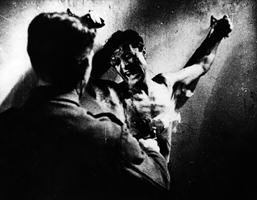

Italy 1945
bw 105 min.
Director: Roberto Rossellini
CLV: $49.95 - available
1 disc, catalog # CC1409L
 Untitled Document
Untitled Document
Roma, citta aperta is widely regarded as the most important film
in Italian cinema history. On its release in 1945, it seemed utterly different
from anything made before. Its use of real locations (rather than studios)
and unglamourous nonprofessional actors (except in the major rolls) gave
it a startling, authentic look that was to change forever all subsequent
filmmaking practice.
The making of the film was carried out in the worst possible conditions,
just after occupying German troops had left Rome. Most producers had left
the city; the studios at Cinecitta had been severly damaged by Allied aerial
attacks. In a country on the verge of social and economic collapse, there
was little money available for something as frivolous and nonessential as
film. Yet these very hardships make Open City unique. The fact that
Rossellini had to buy his film stockfrom street photographers, splicing
together unmatched bits and pieces, is responsible for the film's newsreel
feel. Rossellini was forced to film in the streets and in his collaborator's
apartments because the large studios were in such bad shape. Ambient sound
and the actor's voices were dubbed in after editing.
Despite its fame, Open City is probably Rossellini's least typical
work. Though seen as a direct challenge to the conventions of conventional
Hollywood cinema, it is in fact one of the director's most conventional
efforts in terms of its narrative and dramatic structure. In 1945, the story
that Rossellini wanted to tell perhaps seemed so powerful in and of itself
that a driving narrative impulse may simply have pushed aside the more experimental
narrative technique of his earlier films. Reality itself had had become
so dramatic that a strong storyline with vivid characters must have seemed
the best way to capture it. Merely showing the reality of wartime Rome in
its pain and destruction had an enormous impact on audiences around the
world -- even in Italy, which was notoriously hostile to neorealism.
However we might want to chastise Rossellini for his embrace of conventional
narrative, it is clear he does it very well indeed. There is no narrative
fat, the characters are tightly intertwined for maximum efficiency, and
the result is a complex, thickly populated fresco of contemporary Italian
life. Exposition is accompliched instantly, in bold, swift strokes. We are
plunged into the story at a gallop from the first minute of the film. Comic
and tragic moods alternate in an invigorating way: The film's most tragic
scene (in which an incomparable Anna Magnani -- in her first major role
-- is gunned down by the Germans) follows immediately upon what is perhaps
the its most comic (an old man, reluctant to play dead for the benefit of
the fascist police, is hit over the head with a frying pan by Aldo Fabrizi).
The most important theme, however, especially in terms of the film's
historical dimension, concerns the nature of the partnership formed -- if
not historical actuality, at least in Rossellini's mind -- to combat Nazi
corruption, that between communists and the Catholic Church. This was no
mean trick for the director, considering that one of his previous films
had posed them as natural bitter enemies. But he does manage, in a remarkable
balancing act, to portray both favorably, primarily because of the handy
presence of a common enemy whose dreadfulness everyone can agree upon. Nevertheless,
the entire film is presented in Catholic, or Christian, perspective (even
the tortured communist Manfredi is symbolically seen in Christ-like terms),
and the priest Don Pietro is the moral lens through which we are meant to
regard the various forms of iniquity on display. Rossellini acknowledges
the plain fact that no matter how one personally felt concerning its politics,
the Communist Party was the resistance.
The film ends with an ambiguous image of the Roman skyline, as the boys
trudge wearily down the hill, supporting one another, after the execution
of Don Pietro. The sequence seems clearly symbolic, but of what? Some have
emphasized the prominence of the dome of St. Peter's, insisting that only
in the church is there hope for the future of Italy. But the dome is seen
firmly in its context of the entire city of Rome. Others have seen the ending
as utterly pessimistic, full of death and destruction. Still others have
stressed the fact that the boys, symbol's of Italy's future even though
crippled and depressed, are at least supporting one another down the hill.
However one might want to read these final images of the Eternal City, it
is clear that the next fifty yearsof cinema history will be conceived and
realized against the eternal backdrop of Roma, citta aperta.
--Peter Brunette
Peter Brunette teaches film at George Mason University, is the author
of Roberto Rossellini, and frequently contributes to The New York
Times.
CAST & CREDITS
Pina ... Anna Magnani
Don Pietro ... Aldo Fabrizi
Manfredi ... Marcello Pagliero
Marina ... Maria Michi
Bergmann ... Harry Feist
Francesco ... Francesco Grandjacquet
Ingrid ... Giovanna Galletti
Marcello ... Vito Annichiarico
Produced and directed by ... Roberto Rossellini
Written by ... Sergio Amidei, Frederico Fellini & Roberto Rossellini
Based on a a story by ... Sergio Amidei & Alberto Consiglio
Photographed by ... Ubaldo Arata
Music by ... Renzo Rossellini
ABOUT THE TRANSFER
Open City was transferred from a 35mm Nitrate Composite Print.




